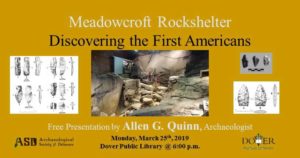
- This event has passed.
Presentation: Meadowcroft Rockshelter by Allen G. Quinn
March 25, 2019 @ 6:00 pm - 7:30 pm
FREE
Allen G. Quinn presents: Meadowcroft Rockshelter Discovering the First Americans
Background (Wikipedia 2017):
ArchaeologyMeadowcroft Rockshelter and other Native American points of interest, Southwestern Pennsylvania
Excavations. Native Americans left the site during the American Revolutionary War. It was not re-discovered until many years later, when, in 1955, Albert Miller found the first artifacts in a groundhog burrow. Miller delayed reporting his findings until he contacted James M. Adovasio, who led the first excavations of the site in 1973 until 1979 by the Cultural Resource Management Program of the University of Pittsburgh. Further University of Pittsburgh field school excavations were conducted through 1989.Since the 1990s, more recent work has also been undertaken by Adovasio through the Mercyhurst Archaeological Institute.The methods of excavation used at Meadowcroft are still seen as state-of-the-art. It is viewed as one of the most carefully excavated sites in North America.
Finds
Meadowcroft has produced what may be pre-Clovis remains, found as deep as 11.5 feet underground. The site also has yielded many tools, including pottery, bifaces, bifacial fragments, lamellar blades, a lanceolate projectile point, and chipping debris. Recoveries of note also include fluted points, which are a marker of the Paleoindian period. Remains of flint from Ohio, jasper from eastern Pennsylvania and marine shells from the Atlantic coast suggest that the people inhabiting the area were mobile and involved in long-distance trade. At least one basin-shaped hearth was reused over time.
Meadowcroft has also yielded the largest collection of flora and fauna materials ever recovered from a location in eastern North America. The arid environment provided the necessary and rare conditions that permitted excellent botanical preservation. In total, animal remains representing 149 species were excavated. Evidence shows that people gathered smaller game animals as well as plants, such as corn, squash, fruits, nuts and seeds.

